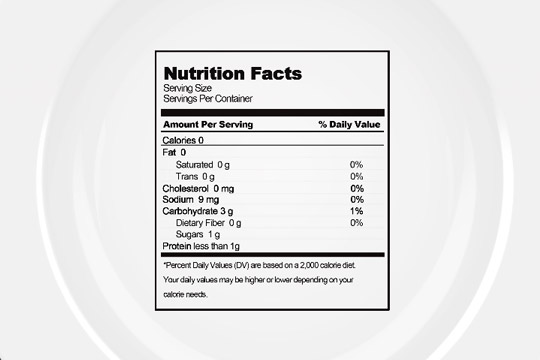
Reducing Food Waste in Foodservice
October 16, 2018 by Doreen Garelick, Dietetic Intern
Our intern Doreen attended a food waste summit for restaurants and compiled these tips to help food service operators redirect…
Nutrition 101
March 20, 2013

Culinary Nutritionist Jason Lau writes on how learning to properly read food labels leads to smarter decision-making when it comes to food choices.
One of the most important steps you can make towards living a healthy and nutritious lifestyle is to learn how to decipher food labels, which can help you make informed decisions while grocery shopping.
In addition to listing calories, food labels can be used determine whether or not the food is a good source of important dietary elements such as fiber, vitamin C or calcium. In order to read the nutrition facts label properly, you should start by looking at the serving size and how many servings are actually in the package. Sometimes the serving size might be a lot less than you would expect to actually consume, causing you to underestimate certain values. If you are eating a cup of a snack that you might think is healthy, but the serving size is actually half a cup, then you’re actually consuming double the amount that you could be inclined to believe -- including the calories and the saturated fat.
The second step to crack the mystery of the food label is to use the daily value (DV) percentages, which are useful numbers to take account of when you’re trying to fit a certain food into your daily meal plan. The DVs – provided by the United States Food and Drug Administration (USDA) -- are the recommended amounts of nutrients for a person with a daily intake of 2000 calories. However, as a daily meal plan is highly individualized, you might need to consume more or less than the DV according to your personal needs. For example, people with anemia might need to consume more iron, whereas people with hypertension may wish to consume less sodium. The general rule is to try to aim high (20% or more) on nutrients like vitamins, minerals or fiber and aim low (5% or less) on saturated fat, cholesterol or sodium.
Lastly, make sure you understand what the health claims really mean on the food labels. The USDA has very strict guidelines on what a company can put on their products as a health claim, but not every consumer is aware of those guidelines. For example, did you know that “Calorie Free” does not necessarily mean 0 calories? You can refer to the table below for some general rules:
|
Reduced |
Less than 25% of a specific nutrient |
|
Good Source of |
10% or more of a specific nutrient |
|
High in |
20% or more of a specific nutrient |
|
Low Calorie |
40 calories or less per serving |
|
Calorie Free |
5 calories or less per serving |
|
Low Sodium |
140mg sodium or less per serving |
So the next time you are doing your grocery shopping, be sure to pay attention to the nutrition facts labels before you buy!
Do you find food labels confusing? Let us know about your experiences with misleading labels in the comments section below.

October 16, 2018 by Doreen Garelick, Dietetic Intern
Our intern Doreen attended a food waste summit for restaurants and compiled these tips to help food service operators redirect food waste from landfills.
Nutrition 101

Nutrition 101
September 26, 2018 by Doreen Garelick, Dietetic Intern
Ever notice headlines about rapid weightloss? Dietetic Intern Doreen Garelick looks deeper into a recent eye-catching headline to see if there's any truth behind it.
Connect
 Follow us on Twitter
Follow us on Twitter Friend us on Facebook
Friend us on Facebook Follow us on Pinterest
Follow us on Pinterest Follow us on Instagram
Follow us on Instagram Read our Blog
Read our Blog Watch videos on YouTube
Watch videos on YouTube Watch videos on Vimeo
Watch videos on Vimeo Connect with us on Linkedin
Connect with us on Linkedin Find us on Foursquare
Find us on Foursquare
Tweets by @SPEcertifiedBlog Search
Categories
SPE Certified Newsletter
Sign up for news on the latest SPE-certified venues, events and SPE updates.
We will never share your personal information with a third party.